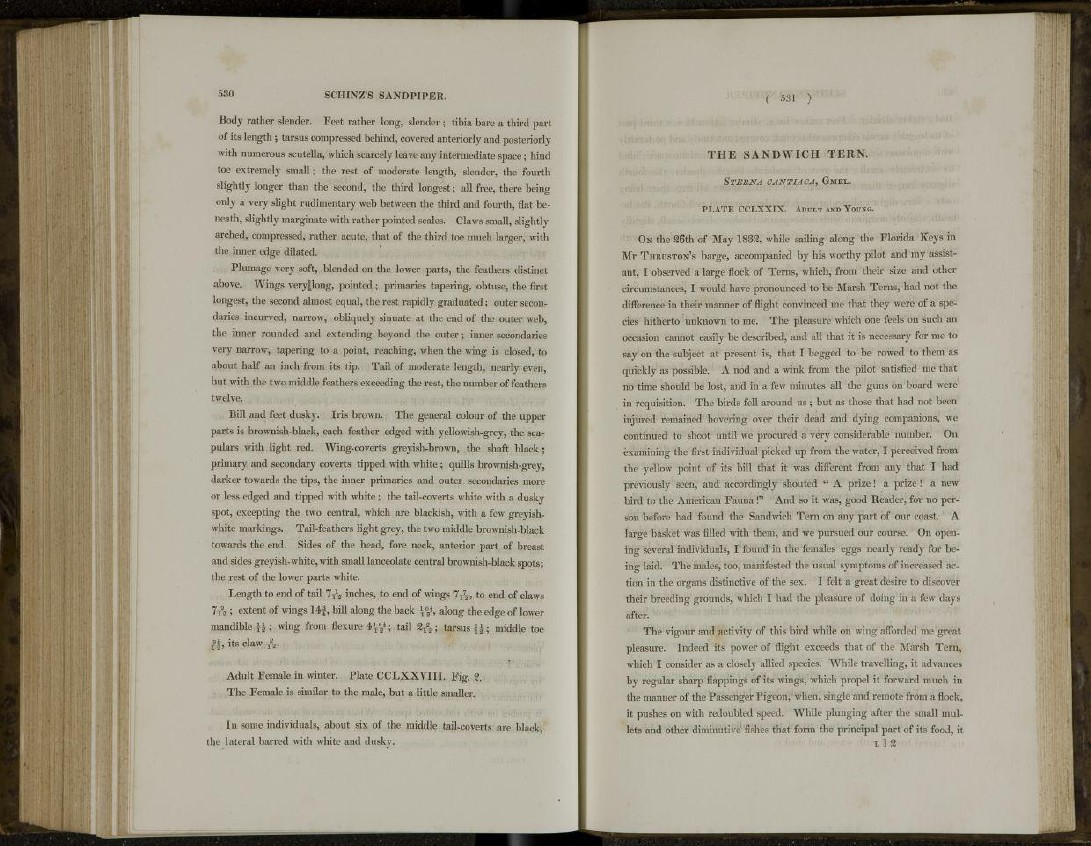
530 S C H I N Z ' S S A N D P I P E R .
Body rather slender. Feet rather long, slender ; tibia bare a third part
of its length ; tarsus compressed behind, covered anteriorly and posteriorly
with numerous scutella, which scarcely leave any intermediate space; hind
toe extremely small; the rest of moderate length, slender, the fourth
slightly longer than the second, the third longest; all free, there being
only a very slight rudimentary web between the third and fourth, flat beneath,
slightly marginate with rather pointed scales. Claws small, slightly
arched, compressed, rather acute, that of the third toe much larger, with
the inner edge dilated.
Plumage very soft, blended on the lower parts, the feathers distinct
above. Wings very|long, pointed; primaries tapering, obtuse, the first
longest, the second almost equal, the rest rapidly graduated; outer secondaries
incurved, narrow, obliquely sinuate at the end of the outer web,
the inner rounded and extending beyond the outer; inner secondaries
very narrow, tapering to a point, reaching, when the wing is closed, to
about half an inch from its tip. Tail of moderate length, nearly even,
but with the two middle feathers exceeding the rest, the number of feathers
twelve.
Bill and feet dusky. Iris brown. The general colour of the upper
parts is brownish-black, each feather edged with yellowish-grey, the scapulars
with light red. Wing-coverts greyish-brown, the shaft black;
primary and secondary coverts tipped with white ; quills brownish-grey,
darker towards the tips, the inner primaries and outer secondaries more
or less edged and tipped with white; the tail-coverts white with a dusky
spot, excepting the two central, which are blackish, with a few greyishwhite
markings. Tail-feathers light grey, the two middle brownish-black
towards the end. Sides of the head, fore neck, anterior part of breast
and sides greyish-white, with small lanceolate central brownish-black spots;
the rest of the lower parts white.
Length to end of tail 7 ^ inches, to end of wings 7T
7
2 , to end of claws
79
2 ; extent of wings 14|, bill along the back along the edge of lower
T
mandible \% ; wing from flexure 4> \°J; tail 2T
2
2 ; tarsus^; middle toe
0i its claw TV
Adult Female in winter. Plate CCLXXVIII. Fig. 2.
The Female is similar to the male, but a little smaller.
In some individuals, about six of the middle tail-coverts are black,
the lateral barred with white and dusky.
( 531 )
THE SANDWICH TERN.
STERNA CANTIACA, GMEL.
P L A T E C C L X X I X . ADULT AND YOUNG.
ON the 26th of May 1832, while sailing along the Florida Keys in
Mr THRUSTON'S barge, accompanied by his worthy pilot and my assistant,
I observed a large flock of Terns, which, from their size and other
circumstances, I would have pronounced to be Marsh Terns, had not the
difference in their manner of flight convinced me that they were of a species
hitherto unknown to me. The pleasure which one feels on such an
occasion cannot easily be described, and all that it is necessary for me to
say on the subject at present is, that I begged to be rowed to them as
quickly as possible. A nod and a wink from the pilot satisfied me that
no time should be lost, and in a few minutes all the guns on board were
in requisition. The birds fell around us; but as those that had not been
injured remained hovering over their dead and dying companions, we
continued to shoot until we procured a very considerable number. On
examining the first individual picked up from the water, I perceived from
the yellow point of its bill that it was different from any that I had
previously seen, and accordingly shouted " A prize! a prize ! a new
bird to the American Fauna!"" And so it was, good Reader, for no person
before had found the Sandwich Tern on any part of our coast. A
large basket was filled with them, and we pursued our course. On opening
several individuals, I found in the females eggs nearly ready for being
laid. The males, too, manifested the usual symptoms of increased action
in the organs distinctive of the sex. I felt a great desire to discover
their breeding grounds, which I had the pleasure of doing in a few days
after.
The vigour and activity of this bird while on wing afforded me great
pleasure. Indeed its power of flight exceeds that of the Marsh Tern,
which I consider as a closely allied species. While travelling, it advances
by regular sharp flappings of its wings, which propel it forward much in
the manner of the Passenger Pigeon, when, single and remote from a flock,
it pushes on with redoubled speed. While plunging after the small mullets
and other diminutive fishes that form the principal part of its food, it
L 1 2